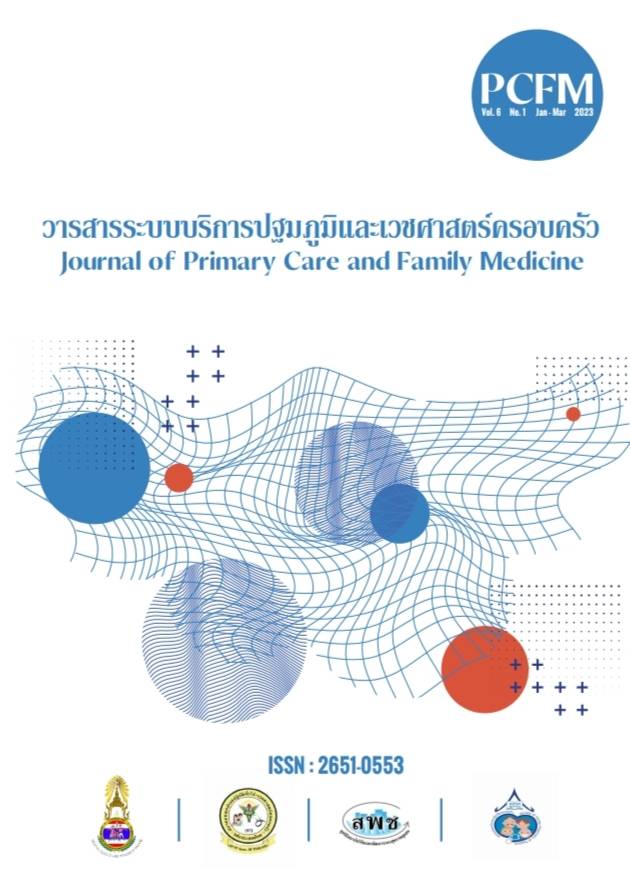ความสัมพันธ์ระหว่างภาวะกรดยูริกในเลือดสูงและระดับความดันโลหิตสูงในแต่ละกลุ่มช่วงอายุ ในตำรวจที่เข้ารับการรักษาและการตรวจสุขภาพ
Main Article Content
บทคัดย่อ
ที่มา: ความดันโลหิตสูงเป็นหนึ่งในภาวะที่พบได้บ่อย ภาวะกรดยูริกสูงนอกจากจะมีความสัมพันธ์กับโรคเก๊าต์แล้ว ยังมีการรายงานความสัมพันธ์กับการเกิดโรคความดันโลหิตสูงอีกด้วยแต่ความสัมพันธ์ระหว่างภาวะกรดยูริกในเลือดสูงในรูปแบบปัจจัยเสี่ยง อิสระกับการเกิด
ระดับความดันโลหิตสูงยังคงไม่มีข้อมูลสรุปชัดเจน ประเทศไทยมีการศึกษาเกี่่ยวกับความสัมพันธ์ดังกล่าวอยู่ไม่มาก และไม่พบการศึกษาที่่เฉพาะเจาะจงกับช่วงอายุ โดยเฉพาะกับอาชีพตำรวจซึ่่งเป็นอาชีพที่่เสี่่ยงต่อการเกิดโรคเรื้้อรังค่อนข้างสูง
วัตถุประสงค์: ศึกษาความสัมพันธ์ของภาวะกรดยูริกในเลือดสูงกับระดับความดันโลหิตสูงในแต่ละกลุ่มช่วงอายุ ในประชากรตำรวจ
วัสดุและวิธีิการ: เป็นการวิจัยเชิงปริมาณ โดยใช้การศึกษาเชิงสังเกต ในรูปแบบภาคตัดขวางเชิงวิเคราะห์์ ในตำรวจที่่เข้ารับการรักษาและตรวจสุุขภาพ ณ คลินิกตำรวจและศูนย์ตรวจสุขภาพ โรงพยาบาลตำรวจ โดยเก็บข้อมูลย้อนหลังจากเวชระเบียนผู้ป่วยนอก เฉพาะผู้ที่่มีอายุุ 30 ปีขึ้้นไป ในช่วงระหว่างวันที่่ 1 มกราคม พ.ศ. 2559 ถึงวันที่่ 31 ธัันวาคม พ.ศ.2561 ใช้สถิติ Multiple linear regression และ Multiple logistic regression โดยปรับอิทธิพลของตัวกวน ได้แก่ เพศ, BMI, cholesterol, HbA1C, eGFR ในการหาความสัมพันธ์ข้างต้น
ผลการศึกษา: ผู้เข้าร่วมงานวิจัย 1,307 คน (แบ่ง 3 กลุ่มช่วงอายุ คือ 30-39 ปี, 40-59 ปี,และ 60 ปีขึ้นไป) การวิเคราะห์พบว่าระดับกรดยูริกในเลือดที่่สูงขึ้นจะสัมพันธ์กับความดันโลหิตซิสโตลิกที่่สูงขึ้นอย่างมีนัยสำคัญในกลุ่มอายุ 30-39 ปี และ 40-59 ปี และสัมพันธ์กับ
ความดันโลหิตไดแอสโตลิกที่่สูงขึ้นอย่างมีนัยสำคัญในกลุ่มอายุ 40-59 ปี โดยสรุป พบว่าภาวะกรดยูริกในเลือดสูงสัมพันธ์กับการเกิดระดับความดันโลหิตสูงอย่างมีนัยสำคัญในกลุ่มอายุ 40-59 ปี
สรุุป: ความสัมพันธ์ระหว่างภาวะกรดยูริกในเลือดสูงกับระดับความดันโลหิตสูงในกลุ่มคนอายุน้อย คือช่วงอายุ 40-59 ปี และพบความสัมพันธ์เชิงบวกของระดับกรดยูริกในเลือดกับความดันโลหิตซิสโตลิกและความดันโลหิตไดแอสโตลิกในกลุ่มคนอายุน้อยเช่นกัน
Article Details

อนุญาตภายใต้เงื่อนไข Creative Commons Attribution-NonCommercial-NoDerivatives 4.0 International License.
เนื้อหาและข้อมูลในบทความที่ลงตีพิมพ์ในวารสาร PCFM ถือเป็นข้อคิดเห็นและความรับผิดชอบของผู้เขียนบทความโดยตรง ซึ่งกองบรรณาธิการวารสารไม่จำเป็นต้องเห็นด้วยหรือร่วมรับผิดชอบใด ๆ
บทความ ข้อมูล เนื้อหา รูปภาพ ฯลฯ ที่ได้รับการตีพิมพ์ลงในวารสาร PCFM ถือเป็นลิขสิทธิ์ของวารสาร PCFM หากบุคคลหรือหน่วยงานใดต้องการนำทั้งหมดหรือส่วนหนึ่งส่วนใดไปเผยแพร่ต่อหรือเพื่อกระทำการใด ๆ จะต้องได้รับอนุญาตเป็นลายลักษณ์อักษรจากวารสาร PCFM ก่อนเท่านั้น
เอกสารอ้างอิง
Fuchs FD, Whelton PK. High blood pressure and cardiovascular disease. Hypertension. 2020;75:285-92.
NCD Risk Factor Collaboration (NCD-RisC). World- wide trends in hypertension prevalence and pro- gress in treatment and control from 1990 to 2019: a pooled analysis of 1201 population-representa- tive studies with 104 million participants. Lancet. 2021;398(10304):957–80.
Thai Hypertension Society. 2019 Thai guidelines on the treatment of hypertension. Chiang Mai: Trick Think publisher; 2019. (in Thai)
Burden of Disease Research Program Thailand. Thailand burden of diseases attributable to risk fac- tors 2014. Nonthaburi: International Health Policy Program; 2018.
สมาคมรูมาติสซั่มแห่งประเทศไทย. แนวทางเวชปฏิบัติการ ดูแลรักษาโรคเกาท์ (Guideline for Management of Gout) พ.ศ. 2555. กรุงเทพฯ: สมาคมรูมาติสซั่มแห่งประเทศไทย; 2555.
Butler F, Alghubayshi A, Roman Y. The Epidemiolo- gy and Genetics of Hyperuricemia and Gout across Major Racial Groups: A Literature Review and Popu- lation Genetics Secondary Database Analysis. J Pers Med. 2021;11:231.
Uaratanawong S, Suraamornkul S, Angkeaw S, Uara- tanawong R. Prevalence of hyperuricemia in Bang- kok population. Clin Rheumatol. 2011;30:887-93.
Kanbay M, Segal M, Afsar B, Kang DH, RodriguezIturbe B, Johnson RJ. The role of uric acid in the pathogenesis of human cardiovascular disease. Heart. 2013;99:759-66.
Sung K-C, Byrne CD, Ryu S, Lee J-Y, Lee SH, Kim J-Y, et al. Baseline and change in uric acid concentra- tion over time are associated with incident hyper- tension in large Korean cohort. Am J Hypertens. 2017;30:42–50.
Kuwabara M, Hisatome I, Niwa K, Hara S, RoncalJimenez CA, Bjornstad P, et al. Uric acid is a strong risk marker for developing hypertension from pre- hypertension: a 5-year Japanese Cohort Study. Hy- pertension. 2018;71:78-86.
Cao Z, Cheng Y, Li S, Yang H, Sun L, Gao Y, et al. Mediation of the effect of serum uric acid on the risk of developing hypertension: a populationbased cohort study. J Transl Med. 2019;17:202.
Cheng YB, Li Y. Hyperuricemia: Does It Matter for the Progression from Prehypertension to Hyperten- sion? Hypertension. 2018;71:66-7.
Lanaspa MA, Andres-Hernando A, Kuwabara M. Uric acid and hypertension. Hypertens Res. 2020;43:832-4.
Piani F, Cicero AFG, Borghi C. Uric acid and hyper- tension: Prognostic role and guide for treatment. J Clin Med. 2021;10:448.
Lee SJ, Oh BK, Sung K-C. Uric acid and cardiometa- bolic diseases. Clin Hypertens. 2020;26:13.
Forman JP, Choi H, Curhan GC. Plasma uric acid level and risk for incident hypertension among men. J Am Soc Nephrol.2007;18:287–92.
Sedaghat S, Pazoki R, Uitterlinden AG, Hofman A, Stricker BH, Ikram MA, et al. Association of uric acid genetic risk score with blood pressure: the Rotter- dam study. Hypertension. 2014;64:1061-6.
Lee JJ, Ahn J, Hwang J, Han SW, Lee KN, Kim JB, et al. Relationship between uric acid and blood pressure in different age groups. Clin Hypertens. 2015;21:14.
Cheng W, Wen S, Wang Y, Qian Z, Tan Y, Li H, Hou Y, et al. The association between serum uric acid and blood pressure in different age groups in a healthy Chinese cohort. Medicine (Baltimore). 2017;96(50): e8953.
Ohyama Y, Imai K, Obokata M, Araki M, Sumiyoshi H, Koitabashi N, et al. Impact of uric acid on in- cident hypertension: Sex-specific analysis in dif- ferent age groups. Int J Cardiol Hypertens. 2019; 2(100009):100009.
Niu X, Chen J, Wang J, Li J, Zeng D, Wang S, et al. Association between the uric acid and hyper- tension in community-based Chinese population: stratified analysis based on body mass index and age. J Thromb Thrombolysis. 2021;51:1113-9.
Aunchalee K. The relationship between uric acid with other laboratory in Phang-nga policeman. Reg11MedJ. 2018;32:1345-56.
Jameson JL, Fauci AS, Kasper DL, Hauser SL, Longo DL, Loscalzo J. Harrison’s principles of internal medicine, twentieth edition (vol.1 & vol.2). 20th ed. Columbus, OH: McGraw-Hill Education; 2018.
Lee SW, Kim HC, Nam C, Lee H-Y, Ahn SV, Oh YA, et al. Age-differential association between serum uric acid and incident hypertension. Hypertens Res [Internet]. 2019 [cited Year Mont Date];42:428–37. Available from: http://dx.doi.org/10.1038/s41440-
-0168-4


